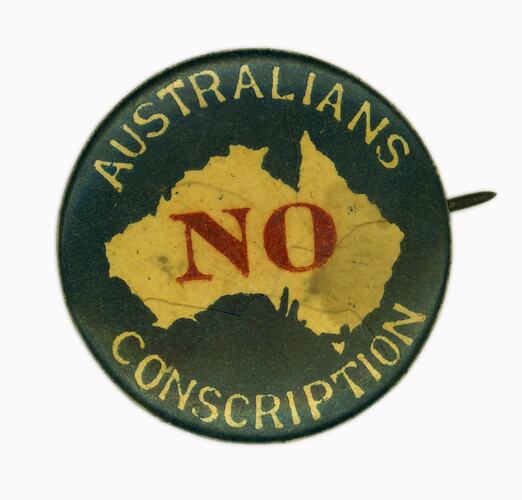Summary
Anti-conscription badge manufactured by A.E. Patrick, Newtown, Sydney, circa 1917.
When war was announced in 1914, support was high; vast numbers of men enlisted to serve in the Australian Imperial Forces (AIF). However stories of lost campaigns and war horrors, coupled with increasing casualty rates saw recruitment levels decline. By 1916 there was a shortage of men to fight overseas; Billy Hughes' Labor government proposed conscription as the solution to declining numbers of men. In a referendum held on 28 October 1916, Australians were asked: 'Are you in favour of the Government having, in this grave emergency, the same compulsory powers over citizens in regard to requiring their military service, for the term of this War, outside the Commonwealth, as it now has in regard to military service within the Commonwealth?' By a very narrow margin (51% against, 49 % for), the people of Australia rejected the referendum. After this failure, Hughes was expelled from the Labor Party. He promptly crossed the floor, along with about half of the parliamentary party, and became prime minister of a conservative Nationalist government.
The problem of declining numbers of men wishing to enlist did not go away. Consequently a second referendum was called. On 20 December 1917 the Australian public were asked: 'Are you in favour of the proposal of the Commonwealth Government for reinforcing the Commonwealth Forces overseas?' The answer was a resounding no. Australia was the only country not to adopt conscription during World War I.
Physical Description
Circular button, dark blue/green background, printing in white curving around the top and bottom, at the centre is a white map of Australia, 'NO' printed in red capital letters on the map. Pin on the back. Manufacturers name and address printed in white on the underside.
More Information
-
Collecting Areas
-
Acquisition Information
Cultural Gifts Donation from Mr Andrew Reeves, 29 Oct 1991
-
Acknowledgement
Donated through the Australian Government's Cultural Gifts Program.
-
Manufacturer
A.E. Patrick, Newtown, Greater Sydney, New South Wales, Australia, circa 1917
-
Place & Date Used
-
Inscriptions
Front: AUSTRALIANS/NO/CONSCRIPTION. Reverse: A.E. PATRICK MAKER 94 WILSON ST NEWTOWN SYD.
-
Classification
-
Category
-
Discipline
-
Type of item
-
overall dimensions
2.7 cm (Length), 2.3 cm (Width), 0.5 cm (Height)
-
Keywords
Conscription, Militaria: Australian, World War I, 1914-1918, War Service


